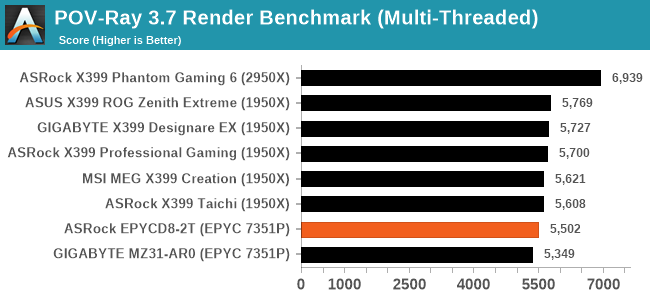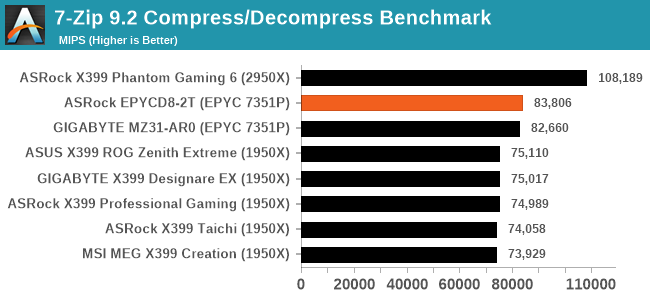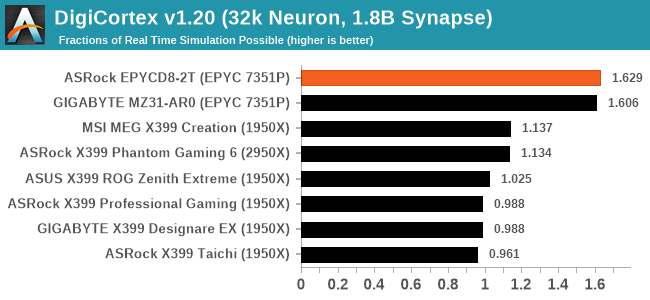The ASRock Rack EPYCD8-2T Motherboard Review: From Naples to Rome
by Gavin Bonshor on April 20, 2020 9:00 AM EST- Posted in
- Motherboards
- AMD
- Workstation
- server
- ASRock Rack
- Naples
- Rome
- EPYC 7351P
- EPYCD8-2T
CPU Performance, Short Form
For our motherboard reviews, we use our short form testing method. These tests usually focus on if a motherboard is using MultiCore Turbo (the feature used to have maximum turbo on at all times, giving a frequency advantage), or if there are slight gains to be had from tweaking the firmware. We put the memory settings at the CPU manufacturers suggested frequency, making it very easy to see which motherboards have MCT enabled by default.
For this review we are running using Windows 10 64-bit with the 1909 update as per our Ryzen Threadripper 3960X and 3970X CPU review.
Rendering - Blender 2.8: 3D Creation Suite - link
A high profile rendering tool, Blender is open-source allowing for massive amounts of configurability, and is used by a number of high-profile animation studios worldwide. The organization recently released a Blender benchmark package, a couple of weeks after we had narrowed our Blender test for our new suite, however their test can take over an hour. For our results, we run one of the sub-tests in that suite through the command line - a standard ‘bmw27’ scene in CPU only mode, and measure the time to complete the render.

Rendering – POV-Ray 3.7.1: Ray Tracing - link
The Persistence of Vision Ray Tracer, or POV-Ray, is a freeware package for as the name suggests, ray tracing. It is a pure renderer, rather than modeling software, but the latest beta version contains a handy benchmark for stressing all processing threads on a platform. We have been using this test in motherboard reviews to test memory stability at various CPU speeds to good effect – if it passes the test, the IMC in the CPU is stable for a given CPU speed. As a CPU test, it runs for approximately 1-2 minutes on high-end platforms.

Synthetic – 7-Zip v1805: link
Out of our compression/decompression tool tests, 7-zip is the most requested and comes with a built-in benchmark. For our test suite, we’ve pulled the latest version of the software and we run the benchmark from the command line, reporting the compression, decompression, and a combined score.
It is noted in this benchmark that the latest multi-die processors have very bi-modal performance between compression and decompression, performing well in one and badly in the other. There are also discussions around how the Windows Scheduler is implementing every thread. As we get more results, it will be interesting to see how this plays out.

Point Calculations – 3D Movement Algorithm Test: link
3DPM is a self-penned benchmark, taking basic 3D movement algorithms used in Brownian Motion simulations and testing them for speed. High floating point performance, MHz, and IPC win in the single thread version, whereas the multithread version has to handle the threads and loves more cores. For a brief explanation of the platform agnostic coding behind this benchmark, see my forum post here.

Neuron Simulation - DigiCortex v1.20: link
The newest benchmark in our suite is DigiCortex, a simulation of biologically plausible neural network circuits, and simulates activity of neurons and synapses. DigiCortex relies heavily on a mix of DRAM speed and computational throughput, indicating that systems which apply memory profiles properly should benefit and those that play fast and loose with overclocking settings might get some extra speed up. Results are taken during the steady-state period in a 32k neuron simulation and represented as a function of the ability to simulate in real time (1.000x equals real-time).











34 Comments
View All Comments
romrunning - Monday, April 20, 2020 - link
Would it be possible to get a review of more recent AMD server boards from ASRockRack, like the ROMED8HM3 (SP3 socket, supports EPYC Rome, has many PCIe 4.0 slots)?Slash3 - Monday, April 20, 2020 - link
The ASRock Rack ROMED8-2T is a similarly near perfect board for the current Epyc CPUs; I'd love to see some reviews once it hits retail channels (within a few weeks, hopefully).https://www.asrockrack.com/general/productdetail.a...
cygnus1 - Monday, April 20, 2020 - link
I plan to build a new home server before the end of the year so I went and checked that one out. I do want it to be AMD, and not really caring if it's Epyc or Ryzen, just need to find a good board with IPMI like these AsrockRack ones. The only problem I see for me with the ROMED8-2T is no x16 slots and the x8 slots are all closed ended for some reason, so you can't even put an x16 card in them.brucethemoose - Monday, April 20, 2020 - link
All 7 slots on the ROMED8-2T are x16.https://www.asrockrack.com/photo/ROMED8-2T-1(M).jp...
Foeketijn - Tuesday, April 21, 2020 - link
Not sure what the requirements are, but I can endorse the Asrockrack X470 boards. Ryzens Zen2 and the x470 make a really efficient powerhouse (just 100 Watts for a 8 core in a noisy but cool 1u server doing stress testing)romrunning - Monday, April 20, 2020 - link
Or the ROMED8-2T or ROMED8QM-2T? Really, I guess any of the newer "ROME" models that ASRockRack has listed. These newer boards would be more relevant than the older EPYCD8-2T, of which the ROMED8-2T seems like it's the direct successor.Mr Perfect - Tuesday, April 21, 2020 - link
Yes, please review Epyc boards with PCIe 4. There are several in this price range that have it, so it's not really beneficial to look at boards of the same cost that have half the IO bandwidth.Tyan's S8030GM4NE-2T has five x16 4.0 slots and the two 10gb Ethernet ports. I'd love to know if that board was any good.
shabby - Monday, April 20, 2020 - link
Only two 10g ports? Come on where are my 100g ports...vladpetric - Monday, April 20, 2020 - link
100g is not something that a CPU-based system can saturate. High end switches, aggregating traffic from multiple end points - sure. Software running on a CPU - no.eastcoast_pete - Monday, April 20, 2020 - link
I don't think that question was asked in earnest. However, if it was, I agree with you.